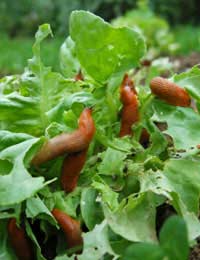Common Leaf Pests

Few things cause so much anguish to the avid gardener as damaged, discoloured or distorted leaves – particularly when the plants seemed to have been enjoying the very best of health only a matter of days before.
It is one of the inevitable and unfortunate ironies of gardening that the best kept and most vigorous specimens are the most attractive sources of a free feed to a whole host of pests, making defending our prized plants against so many hungry mouths a bit of an uphill struggle. However, knowing your enemy can certainly give you the edge.
Eaten Leaves
Aside of slugs, snails, rabbits and deer, the number of creatures lining up to take bites out of your well-tended plants is vast, with the caterpillars of various moth and butterfly species being high on the list.Fortunately, it is usually a simple matter to diagnose caterpillar damage – principally because the culprits are easily spotted! Where practical, picking them off by hand offers the most simple solution, while covering affected plants with fine mesh netting or horticultural fleece can often be the best way to achieve longer-term control. However, for large-scale infestations, it may be necessary to resort to an appropriate form of insecticide, such as pyrethrin or bifenthrin.
Other common offenders include sawfly larvae and various forms of beetles – all of which will tend to respond well to similar methods of treatment.
Wilted and Discoloured Leaves
Aphids and whitefly can make a nuisance of themselves on most kinds of plants, the main symptoms of infection being wilted leaves covered with sticky “honeydew” – in reality, insect excrement – and often blackened by sooty moulds. In severe cases, this may also extend to the stems and new buds.There are many products suitable for dealing with these pests, ranging from the homely and traditional approach involving spraying affected plants with a solution of washing up liquid to any one of a number of proprietary insecticides – or even growing Pyrethrum as companion plants.
Dull and increasingly yellowed leaves, with a fine patchwork of mottling on their upper surfaces are often an indication of red spider mites. These pests can affect a wide range of plants, including trees, shrubs, vegetables, fruits, garden annuals, perennials, bulbs and houseplants.
These small 1mm-long mites are normally yellow-green, marked with black, only turning reddish-orange in the autumn, which can sometimes lead to misdiagnosis of the problem. The two-spotted – or greenhouse – red spider mite (Tetranychus urticae) is the most common kind to be encountered and despite its name, it will affect garden plants as readily as indoor ones.
Unfortunately controlling these pests can be challenging, since they reproduce extraordinarily swiftly when conditions suit them and many strains have developed which are resistant to pesticides. In greenhouses, keeping the humidity high and misting the under-surface of the leaves with water can be helpful, and there is also a biological control available in the form of another kind of mite Phytoseiulus persimilis which is effective if the infestation is not too heavy.
Eeelworms and Miners
Infestations of leaf eelworms (Aphelenchoides) or the larvae of leaf mining insects can pose real problems for the amateur gardener, not least because there are no pesticides currently available for domestic use to deal with them.Living within the leaf itself and eating it from the inside, these pests can cause plants to suffer disfiguring damage very quickly. The symptoms in all cases are similar, with discoloured patches – often black or brown in colour – appearing beneath the surface, typically between the leaf-veins.
Although many of the various species of eelworms and insect larvae make different shaped patches, which can be useful in identifying which kind is responsible, knowing which sort is present is of little more than passing interest, since the course of action is the same for all.
Sadly, there is no alternative to removing and burning the infected material – if the area affected is small and the problem has been caught soon enough this may mean only the damaged leaves, but if the pests are well established, whole plants may have to be sacrificed.
Although sometimes the queue of insects and others biding their time for a free feed on your plants can seem almost endless, most common leaf pests can be dealt with, even if – as in the case of leaf miners and their kin – the best you can do is stop them from spreading.
Fortunately destroying plants is usually a last resort and most common garden pests can be discouraged from becoming too much of a nuisance in the first place. Many gardeners swear by natural control methods, such as growing suitable companion plants, such as garlic and onion to keep aphids away or rosemary and thyme to stop caterpillar damage, while modern pesticides, used correctly, can often stop things getting out of hand.
In the end, whatever strategy you choose, it is worth remembering that there is no substitute for vigilance – and knowing what to look for, of course!







